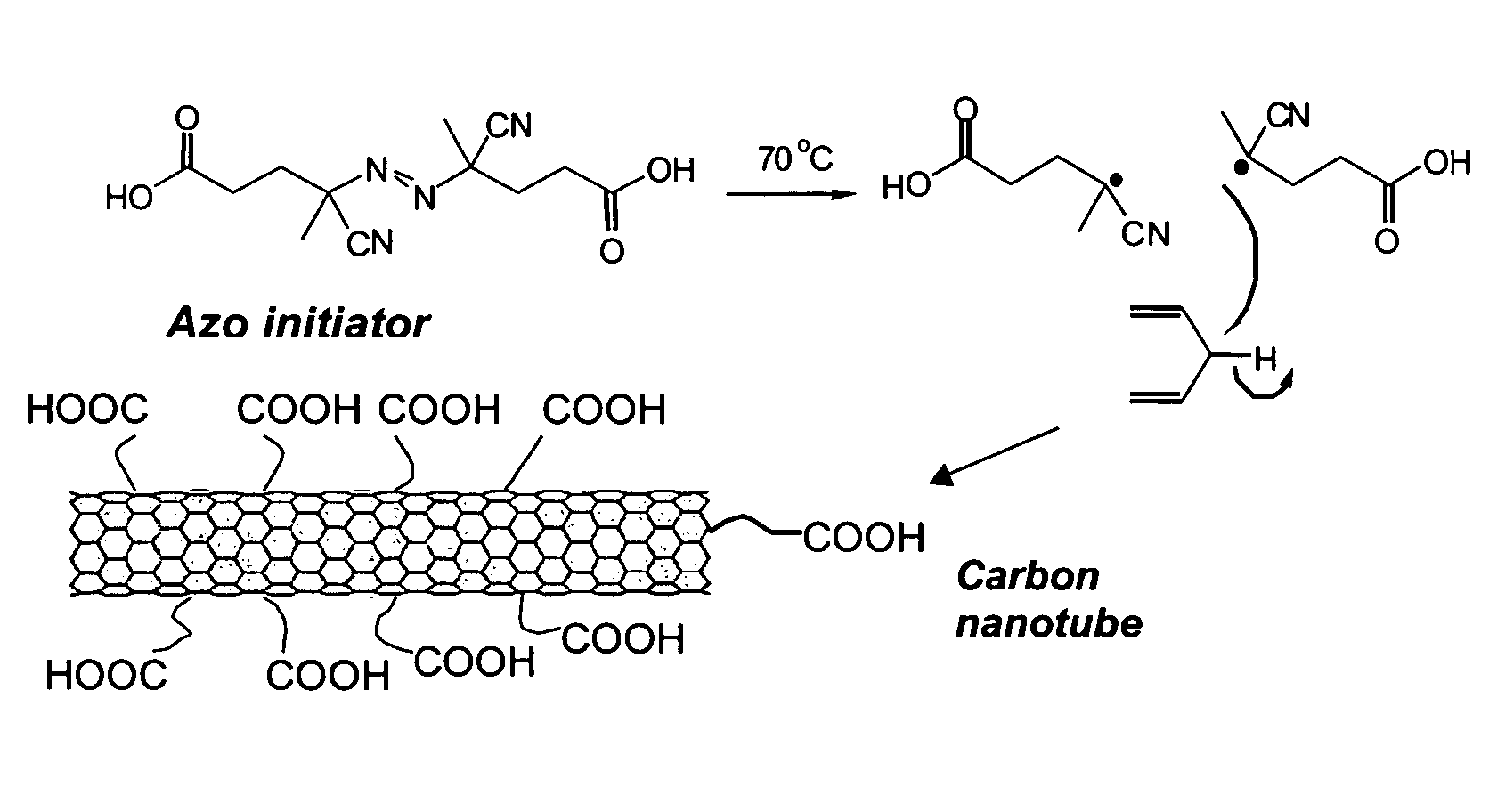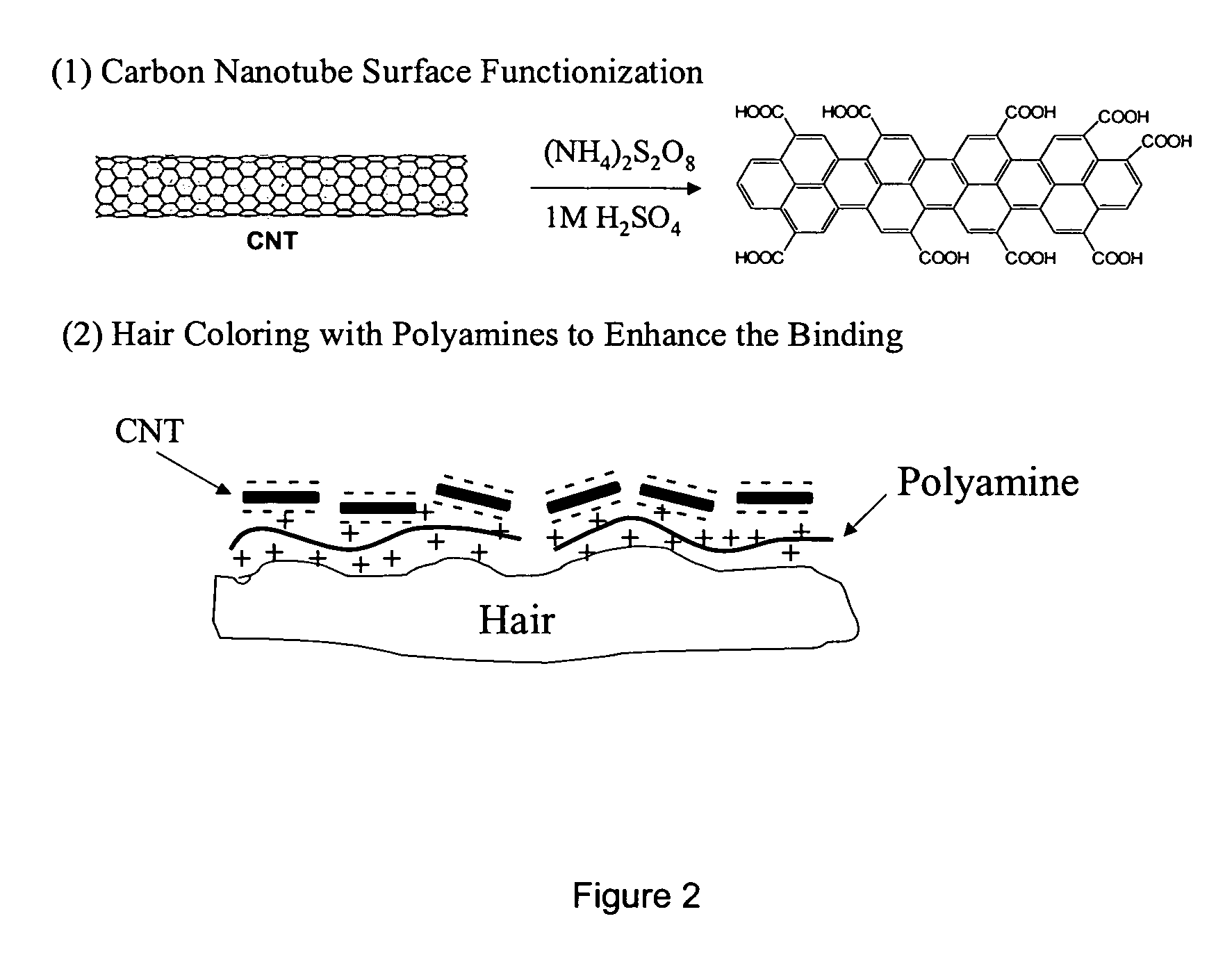Hair coloring and cosmetic compositions comprising carbon nanotubes
a technology of carbon nanotubes and pigments, applied in the field of personal care products, can solve the problems of poor adhesion of pigments to hair, hair damage, difficult production of antibodies, and high cost of pigments
- Summary
- Abstract
- Description
- Claims
- Application Information
AI Technical Summary
Benefits of technology
Problems solved by technology
Method used
Image
Examples
example 1
Preparation of Chemically Functionalized Carbon Nanotubes
[0063]The purpose of this Example was to prepare chemically functionalized carbon nanotubes. The carbon nanotubes were treated with ammonium persulfate in sulfuric acid.
[0064]Multi-walled carbon nanotubes (50 mg, HiPCo from Carbon Nanotechnologies Inc., Houston, Tex.) were added to a 50 mL beaker and mixed with 5.0 g of ammonium persulfate (98% from Aldrich, Milwaukee, Wis.) and 15.0 mL of a 1.0 M H2SO4 (98%, GR grade from EM Science, Gibbstown, N.J.) aqueous solution by stirring with a magnetic stir plate at room temperature for 48 h. The reaction mixture was transferred into two 15 mL plastic centrifuge tubes and centrifuged at 8,500 rpm for 2 min. The supernatant became clear and was removed. The product was washed with water 5 times using centrifugation to collect the nanotubes. The time required to centrifuge the nanotubes increased with each wash, indicating that the size of the nanotubes was in the nanometer range. The ...
example 2
Coloring Normal White Hair with Chemically Functionalized Carbon Nanotubes
[0065]The purpose of this Example was to dye a sample of natural white hair using the chemically functionalized carbon nanotubes prepared in Example 1.
[0066]A bundle of natural white hair (approximately 100 pieces) (from International Hair Importers and Products Inc., Bellerose, N.Y.) was cleaned by mixing with 10 mL of 50% isopropanol for 30 min to remove the oily or greasy material from the hair surface, and then washed at least 5 times with distilled water. After drying in air, the cleaned hair was immersed for 10 min in a solution containing 5 mg of chemically functionalized carbon nanotubes, prepared as described in Example 1, dissolved in 10 mL of distilled water. After dying, the hair was washed at least 5 times with distilled water. The original natural white hair became light black. The dyed hair was washed three times with a 30% shampoo solution (Pantene Pro-V shampoo, Proctor & Gamble, Cincinnati, O...
example 3
Coloring Beached Hair with Chemically Functionalized Carbon Nanotubes
[0067]The purpose of this Example was to dye a sample of bleached, natural white hair using the chemically functionalized carbon nanotubes prepared in Example 1.
[0068]To prepare a bleached hair sample, natural white human hair (International Hair Importers and Products Inc.) was placed in 6% H2O2, which was adjusted to pH 10.2 with ammonium hydroxide, for 10 min at room temperature. The hair sample was then washed 5 times for 5 min each with deionized water, and air-dried overnight at room temperature. A bundle of bleached natural white hair (approximately 100 pieces) was immersed for 10 min in a solution containing 5 mg of chemically functionalized carbon nanotubes, prepared as described in Example 1, dissolved in 10 mL of distilled water. The hair sample was air-dried and then washed at least 5 times with distilled water. The original bleached, white hair became black. The dyed hair was washed three times with a ...
PUM
| Property | Measurement | Unit |
|---|---|---|
| particle diameter | aaaaa | aaaaa |
| particle diameter | aaaaa | aaaaa |
| particle diameter | aaaaa | aaaaa |
Abstract
Description
Claims
Application Information
 Login to View More
Login to View More - R&D
- Intellectual Property
- Life Sciences
- Materials
- Tech Scout
- Unparalleled Data Quality
- Higher Quality Content
- 60% Fewer Hallucinations
Browse by: Latest US Patents, China's latest patents, Technical Efficacy Thesaurus, Application Domain, Technology Topic, Popular Technical Reports.
© 2025 PatSnap. All rights reserved.Legal|Privacy policy|Modern Slavery Act Transparency Statement|Sitemap|About US| Contact US: help@patsnap.com



